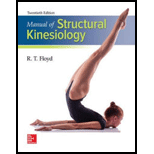
Concept explainers
To list: The planes in which each of the given hip joint movements occurs.
Introduction: The hip joint is the articulation of the pelvis in association with the femur that connects the axial skeleton with the lower extremity. It is the ball and socket joint. The femur is the longest bone of the body, which projects out laterally from its head and angles back toward the midline where it forms the proximal bone of the knee.
Explanation of Solution
The planes in which each of the given hip joint movements occurs are as follows:
- a. Flexion - The plane in which the flexion occurs is the sagittal plane.
- b. Extension - The plane in which the extension occurs is the sagittal plane.
- c. Adduction - The plane in which the adduction occurs is the frontal plane.
- d. Abduction - The plane in which the abduction occurs is the frontal plane.
- e. External rotation - The plane in which the external rotation occurs is the transverse plane.
- f. Internal rotation - The plane in which the internal rotation occurs is the transverse plane.
To list: The respective axis of rotation for each movement in each plane.
Introduction: The hip joint is the articulation of the pelvis in association with the femur that connects the axial skeleton with the lower extremity. It is the ball and socket joint. The femur is the longest bone of the body, which projects out laterally from its head and angles back toward the midline where it forms the proximal bone of the knee.
Explanation of Solution
The respective axes of rotation in which each of the given hip joint movements occurs are as follows:
- a. Flexion - The flexion movement occurs in the frontal axis of rotation.
- b. Extension - The extension movement occurs in the frontal axis of rotation.
- c. Adduction - The adduction movement occurs in the sagittal axis of rotation.
- d. Abduction - The abduction movement occurs in the sagittal axis of rotation.
- e. External rotation - The external rotation occurs in the vertical axis of rotation.
- f. Internal rotation - The internal rotation occurs in the vertical axis of rotation.
Want to see more full solutions like this?
Chapter 8 Solutions
Manual of Structural Kinesiology
 Human Anatomy & Physiology (11th Edition)BiologyISBN:9780134580999Author:Elaine N. Marieb, Katja N. HoehnPublisher:PEARSON
Human Anatomy & Physiology (11th Edition)BiologyISBN:9780134580999Author:Elaine N. Marieb, Katja N. HoehnPublisher:PEARSON Biology 2eBiologyISBN:9781947172517Author:Matthew Douglas, Jung Choi, Mary Ann ClarkPublisher:OpenStax
Biology 2eBiologyISBN:9781947172517Author:Matthew Douglas, Jung Choi, Mary Ann ClarkPublisher:OpenStax Anatomy & PhysiologyBiologyISBN:9781259398629Author:McKinley, Michael P., O'loughlin, Valerie Dean, Bidle, Theresa StouterPublisher:Mcgraw Hill Education,
Anatomy & PhysiologyBiologyISBN:9781259398629Author:McKinley, Michael P., O'loughlin, Valerie Dean, Bidle, Theresa StouterPublisher:Mcgraw Hill Education, Molecular Biology of the Cell (Sixth Edition)BiologyISBN:9780815344322Author:Bruce Alberts, Alexander D. Johnson, Julian Lewis, David Morgan, Martin Raff, Keith Roberts, Peter WalterPublisher:W. W. Norton & Company
Molecular Biology of the Cell (Sixth Edition)BiologyISBN:9780815344322Author:Bruce Alberts, Alexander D. Johnson, Julian Lewis, David Morgan, Martin Raff, Keith Roberts, Peter WalterPublisher:W. W. Norton & Company Laboratory Manual For Human Anatomy & PhysiologyBiologyISBN:9781260159363Author:Martin, Terry R., Prentice-craver, CynthiaPublisher:McGraw-Hill Publishing Co.
Laboratory Manual For Human Anatomy & PhysiologyBiologyISBN:9781260159363Author:Martin, Terry R., Prentice-craver, CynthiaPublisher:McGraw-Hill Publishing Co. Inquiry Into Life (16th Edition)BiologyISBN:9781260231700Author:Sylvia S. Mader, Michael WindelspechtPublisher:McGraw Hill Education
Inquiry Into Life (16th Edition)BiologyISBN:9781260231700Author:Sylvia S. Mader, Michael WindelspechtPublisher:McGraw Hill Education





